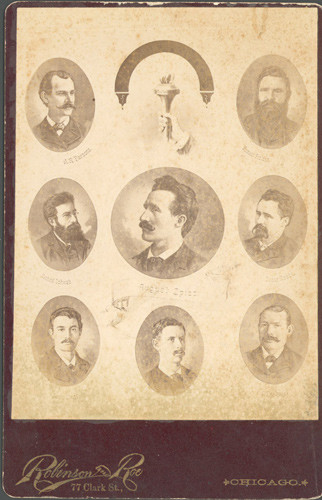Americana: Illinois
14 Oct - 01 Nov 2008

The Haymarket Affair Defendants, 1887. August Spies in the center surrounded with, clockwise from upper left: A. R. Parsons, Samuel Fielden, Oscar Neebe, George Engel, Adolph Fischer, Louis Lingg, and Michael Schwab. Photo: Robinson and Roe. Courtesy of the Chicago History Museum. Haymarket Affair Digital Collection.
AMERICANA: ILLINOIS
One Ray of Thy Light, O Sun! One Stroke of Thy Arm, O Labor!
Mary Augustine Gallery
Oct. 14–Nov. 1, 2008
The exhibition One Ray of Thy Light, O Sun! One Stroke of Thy Arm, O Labor! examines the significance of the Haymarket Affair, a series of demonstrations by striking workers during the first week of May 1886, in Chicago. Integral to the foundation of the labor movement and the establishment of worker's rights in the US, these events also led to the formation of an International Worker's day, commemorated on the first of May.
In the late 19th century, Illinois represented an important intersection in the middle of the country for economic and cultural circulation. The city of Chicago in particular became a flourishing economy and attracted many immigrants from abroad seeking to join the labor force. However, this rapid industrialization and urbanization also produced exploitive conditions for workers. On May 1 1886, the Federation of Organized Trades and Labor Unions coordinated a general strike in support of an eight-hour workday. During the strike, infuriated by acts of police brutality, a group of mostly immigrant socialist and anarchist labor leaders called for a meeting near Chicago's Haymarket Square. When police marched into this crowd to disperse them, an unknown participant hurled a bomb into their ranks, killing a policeman. This started a chain reaction and led to eight prominent anarchists being arrested, convicted, and, in most cases, sentenced to death. Transmitted through wire and newsprint, these events became a rallying cry for worker's rights and resistance around the world.
The chaotic Haymarket Affair raised important questions regarding labor, immigration, capital, rebellion, and the prosecution of dissenters that still linger today. Immigrant laborers have long been treated as expendable labor; their marginalized status serves the system of production. Labor struggle continues to be seen as an outside force corrupting the status quo rather than a necessary consequence of the exploitive conditions of capitalism.
In the exhibition, printed reproductions of Haymarket rally posters and flags call the present into action by awakening this past. The eight anarchists' infamous speeches in their defense play from headphones and pulse in Morse code from a replica of the bomb, a reminder of their resistance.
Curated by Matthew Post and Xiaoyu Weng
One Ray of Thy Light, O Sun! One Stroke of Thy Arm, O Labor!
Mary Augustine Gallery
Oct. 14–Nov. 1, 2008
The exhibition One Ray of Thy Light, O Sun! One Stroke of Thy Arm, O Labor! examines the significance of the Haymarket Affair, a series of demonstrations by striking workers during the first week of May 1886, in Chicago. Integral to the foundation of the labor movement and the establishment of worker's rights in the US, these events also led to the formation of an International Worker's day, commemorated on the first of May.
In the late 19th century, Illinois represented an important intersection in the middle of the country for economic and cultural circulation. The city of Chicago in particular became a flourishing economy and attracted many immigrants from abroad seeking to join the labor force. However, this rapid industrialization and urbanization also produced exploitive conditions for workers. On May 1 1886, the Federation of Organized Trades and Labor Unions coordinated a general strike in support of an eight-hour workday. During the strike, infuriated by acts of police brutality, a group of mostly immigrant socialist and anarchist labor leaders called for a meeting near Chicago's Haymarket Square. When police marched into this crowd to disperse them, an unknown participant hurled a bomb into their ranks, killing a policeman. This started a chain reaction and led to eight prominent anarchists being arrested, convicted, and, in most cases, sentenced to death. Transmitted through wire and newsprint, these events became a rallying cry for worker's rights and resistance around the world.
The chaotic Haymarket Affair raised important questions regarding labor, immigration, capital, rebellion, and the prosecution of dissenters that still linger today. Immigrant laborers have long been treated as expendable labor; their marginalized status serves the system of production. Labor struggle continues to be seen as an outside force corrupting the status quo rather than a necessary consequence of the exploitive conditions of capitalism.
In the exhibition, printed reproductions of Haymarket rally posters and flags call the present into action by awakening this past. The eight anarchists' infamous speeches in their defense play from headphones and pulse in Morse code from a replica of the bomb, a reminder of their resistance.
Curated by Matthew Post and Xiaoyu Weng
